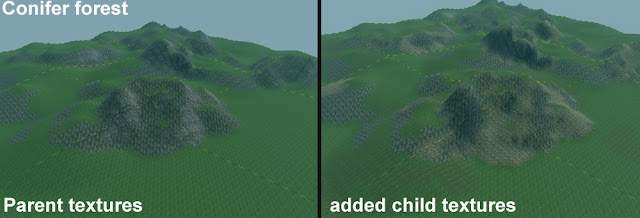Original posted December 16 2013
The region generation feature in Skyrims Creation Kit that lets you automate landscaping. It saves a lot of time compared to painting the terrain and placing every object by hand.
To get good regions can be tricky, there are many parameters to tweak and the learning curve is rather steep. I’m still learning and had the good fortune to have a good teacher, Noir, who has been working with region generation for years. In this guide and those to come I will try to share what I have learned. The region generation feature was also present in Bethesda’s older games and I recommend also looking at guides from Morrowind, Oblivion and Fallout.
I’ll start with the basics, how to generate landscape textures and show examples of Hoddminir region settings. A later guide will look at generation of objects.
How to create a new region
1. To open the Region editor, go to World, Regions
2. Choose your worldspace in the drop down menu
3. Right click in the Region Name list, choose New Region
4. In the General tab, you can change the name and color of the region
5. To add textures or objects you drag them from the Object Window list to the Generated Objects window.
Parent and Child
A important concept in region generation is Parent and Child object or texture.Textures and Objects are added as a base object, called Parents, or as an under objects to that Parent called Child. Parents gets generated first and the generation of children is dependent on the placement of the Parent.
Settings
There are two tab that is of interest for landscape textures, Objects and Objects (more). The main setting parameters that you will be working with are:Density Range 1-100
Min and Max slope Range 0-90
Min and Max height Cut of in units that limits how high or low the texture will be applied on the terrain.
Clustering Range 1-100
For a more comprehensive explanation look at the Oblivion Construction Set wiki page
Lets have a look at the different parameters and how they effect generation of Parent vs Child textures. To illustrate the effect of the settings I show some examples.
Parent texture
Density
How much this Parent texture will blend with other Parent textures.Note that the first Parent in the list will regardless of value be calculated at 100% if the total number of parent textures are less then 100%.
In the test I had two Parents, with the density for the second Parent ranging from 100, 80, 50, 30 and 10%.
Clustering
Clustering determine random terrain vertices drop outs of the parent texture to allow other parent textures to blend throw.
Child textures
Density
Amount of in land area covered (not blend) that the Child texture will occur on.
In the test I had one Child, with the density ranging from 100, 80, 50, 30 and 10%.
Clustering
Noise or breakup of the Child texture. High values will be more broken up, low values will give larger patches. Child textures are always at a 100% blend.
In the test I had one Child, with the clustering ranging from 100, 80, 50, 30 and 10%.
Child texture to an object
Density is always calculated as 100% (regardless of value) and clustering has no effect. Radius of child texture is controlled by the vertex color radius slider, 0-200% of the objects set radius.
A good example how to use this feature is for covering the ground under trees with a landscape texture of dead leaves.
Example region settings
When designing a new region it is important to know that there is a limit to how many landscape textures that can be used. A cell is divided in to 4 quads, and there cam be a maximum of 6 landscape textures per quad. Any more texture added to the landscape will show up as black.
When painting the terrain by hand you could if careful actually get in 6 x 4 textures in a cell.
But region generation applies textures all over a cell, so this means practically that you should not have more than 5-6 landscape textures in your setting. Sometimes you will want to make an exceptions to this rule, like when having one set of textures above and another below the water level. It will usually give some black texture artifacts in the border cells that must be fixed by hand.
The Creation kit can some times be a bit tricky to work with, and Region generation is no exception. Another good thing to know is that when changing a value of an texture or object the CK will not always register this change. Select another entry and the select the entry you changed and see that the change is really there.
In the examples below we work with different settings of slopes, clustering and density. Note how different the landscape will look when adding Child textures to the Parents compared to just having the Parent texture. The textures used in the regions are from the Hoddminir ground texture pack.
Hoddminir settings
Conifer forest

Moorland
Mountain
Deciduous forest
/Elinen














No comments:
Post a Comment